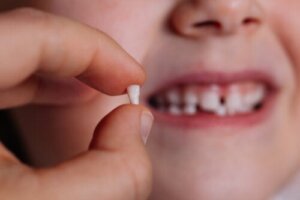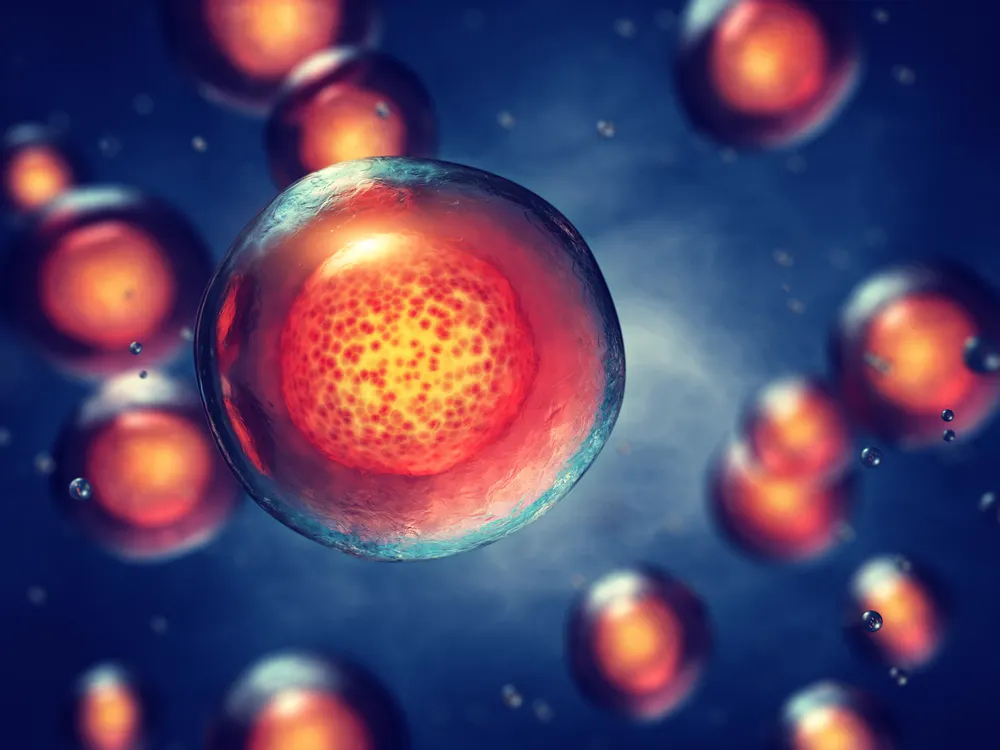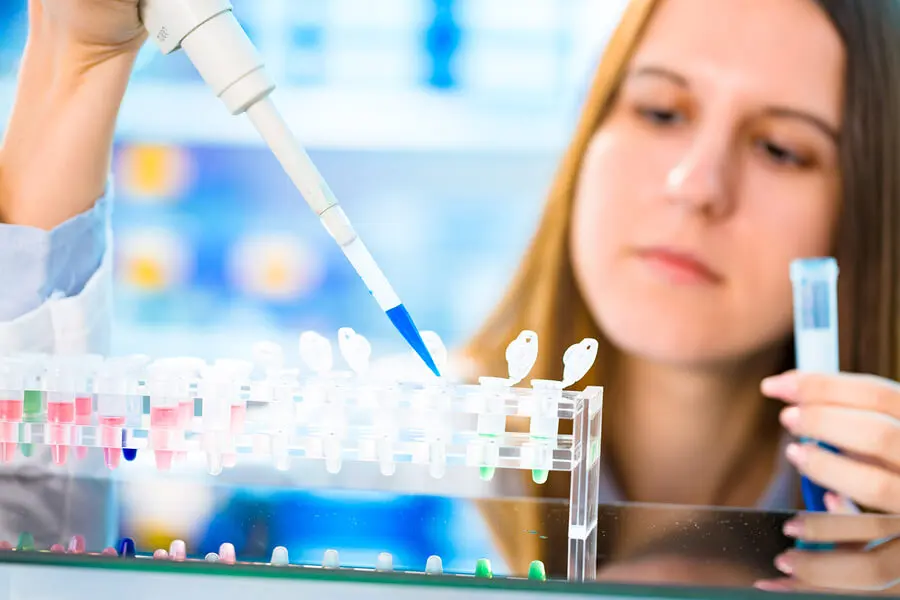Baby Tooth Banks: A Source of Stem Cells

Baby teeth not only play a fundamental role in the mouths of children. It’s now known that baby teeth are also an incredible source of stem cells. That’s where baby tooth banks come in.
Nowadays, there’s more and more research in the field of regenerative medicine. The aim is to take advantage of the benefits of stem cells for the treatment of diseases for which there’s no cure.
In addition, it also makes it possible to restore damaged tissues and organs without the risk of rejection. This is why the discovery of millions of stem cells inside the small baby teeth generates many hopeful expectations. Preserving these teeth in banks created for this purpose could be a health investment for the future.
Protected and sterile within the dental pulp, the stem cells of baby teeth promise great medical solutions in the years to come. We’ll tell you all about this increasingly popular topic in this article.
What are stem cells?
Stem cells are considered to be the most primitive component of the entire body.All the other cells of the body emerge and became specialized from them, each with their specific characteristics and functions.
They are immature and unspecialized cells with the potential to develop into any lineage. Thus, they can become muscle, nerve, bone, cardiac, cartilage, lung or even liver cells, among others.
They also have the particularity of being able to divide and renew themselves, even after long periods of inactivity. In many tissues, this capacity serves for their internal repair and maintenance while the person is alive.
When stem cells divide, the new ones can take two paths:
- Remain a stem cell: This is known as self-renewal.
- Differentiate into another type of specialized cell with a more specific function.
In the body, we possess adult stem cells that help us heal and repair tissues. However, as we age, their numbers and regenerative capacities diminish.
In laboratories, it’s possible to isolate stem cells from certain tissues and take advantage of their potential. In controlled environments, cell division and differentiation can be promoted. This results in new healthy cells capable of replacing damaged cells or repairing injured organs.
This is what regenerative medicine is working on. Having large reserves of stem cells would make it possible to use them when needed in the organ that requires them.
This makes it possible to treat diseases such as Parkinson’s disease, Alzheimer’s, diab,etes and some types of cancer. Stem cells could also be used to repair the heart after a heart attack or to regenerate the liver, skin, neurons, blood, bone, cornea, or muscles.

We think you may also enjoy reading this article: New Cancer Treatment? Photoimmunotherapy Successfully Eliminates Malignant Cells
Baby teeth and stem cells
Stem cells can be found in various adult tissues, such as bone marrow or body fat. In addition, they’re found in greater quantities in embryonic cells, such as those in the umbilical cord or in the amniotic fluid.
A few years ago, the presence of these cells was discovered inside the teeth, in the thickness of the dental pulp. They’re found mainly in baby teeth. However, they can also be found in healthy young permanent teeth.
The stem cells of deciduous teeth have the particularity of being less affected by external and organic factors. The hard layers of the teeth keep them protected and isolated from the outside.
Moreover, they multiply rapidly and could give rise to tissues other than teeth. It’s believed that they’re capable of regenerating muscles, skin, cartilage, bones and other organs. However, more research is still needed to understand their scope and possibilities.
Thus, children’s milk teeth are a source of young stem cells. They’re considered to have more regenerative capacity than those of an adult person.
This raises great expectations for their use in the treatment of disorders that occur at older ages. Because the autologous cells of the patient, due to damage or aging, are not effective.
The therapeutic capacity of stem cells from milk teeth is greater the younger the child is. They can be found in the dental pulp and also in the periodontal ligament, foll,icle and tooth germ.
Their characteristics are similar to those of placental and bone marrow cells. However, there are some differences in their capacity for specialization.
Like this article? You may also like to read: The Link Between the Lymphatic and Circulatory Systems
What’s so special about the stem cells of baby teeth?
As we’ve already told you, we can find stem cells in different organs and tissues of the body. However, those from baby teeth have some special characteristics that have attracted the attention of scientists.
Because of their particularities, they’re be more suitable for use for therapeutic purposes. These are some of the characteristics that differentiate them from the rest:
- They have multipotent potential – that is, they can differentiate into a wide variety of tissues other than teeth. This separates them from hematopoietic stem cells from the umbilical cord, which can only differentiate into other blood and immune system cells.
- They’ve demonstrated interactivity with biomaterials. Being able to combine with other materials makes them ideal for tissue reconstruction.
- They’re expandable and multiply rapidly under controlled conditions.
- They’re abundant and easy to collect. They don’t require invasive intervention, like bone marrow. Through an easy, painless, fast and simple process of tooth extraction, it’s possible to obtain them. Plus, the recovery is easy and comfortable for the child.
- The duration of their availability for collection is long. The collection of healthy stem cells from teeth can be performed between the ages of 5 and 12 years, approximately. This differs from umbilical cord blood, which is available only at birth.
- Since they are taken from children, they are young cells. Therefore, they haven’t had time to deteriorate due to age or disease.
- They are an important source for personal use, but also for research and multiple treatments.
- They can be stored and preserved in banks created for this purpose, making them available when needed.
How are stem cells from baby teeth preserved?
To preserve the stem cells present in baby teeth, it’s necessary to comply with certain steps and care to keep them viable. Previous contact with a bank of milk teeth and the intervention of a dentist are necessary to carry out the process.
First of all, it’s important to know that the teeth from which the cells are going to be extracted must be healthy, without cavities or fillings. In addition, it’s recommended not to wait for them to fall out on their own, as they may not fulfill their purpose after this.
The pulp cells begin to deteriorate when the tooth comes out. For this reason, some services prefer to have a dentist remove the tooth as soon as it loosens.
However, there are tooth banks that will accept self-removing items at home. Neverthless, precise instructions must be followed to preserve them and send them immediately to the preservation center.
When it comes to preserving the stem cells of baby teeth, the most commonly used method is cryopreservation. This consists of freezing the material at -196°C.
This type of preservation is possible in specialized warehouses in scientific laboratories. Currently, in some countries, there are baby tooth banks created to preserve the stem cells of the dental pulp.
Baby tooth banks
Baby tooth banks have emerged in recent years with the aim of enabling people to store their children’s teeth in a safe and professional manner. Families can contact these entities that, for a certain cost, will take care of saving the pulp material.
When the dentist extracts the baby tooth of a child or the wisdom teeth of adults, the stem cells present in the pulp are collected. This isolated material is cultured to increase their number and frozen in cryopreservation chambers with liquid nitrogen.
In this way, if the family needs to use the stem cells at some point, they can access the material that has been kept in optimal conditions. The regenerative capacity of these cells could be harnessed in the treatment of diseases or for new therapies to be developed in the future.
Storing the stem cells from baby teeth means that they will be available at any time in the child’s life. And someday, they could improve or even save the little one or another family member.
Tooth banks have gained popularity in the United States under the slogan “save a tooth, save a life.” The preservation of dental pulp stem cells can represent an investment in future health.
Other countries around the world are joining this trend. Medical advances and family concerns are leading to more and more of these places being willing to preserve stem cells.

How is the process carried out?
We’ve already gone through part of the process of obtaining, separating, and preserving stem cells from milk teeth. Below, we’ll detail it in steps:
- Contact and enrollment in the tooth bank: An application form is filled out, and payment is made for the cryopreservation plan.
- Oral evaluation: Some tooth banks request an orthopantomography of the child to assess tooth replacement patterns. With this data, the patient is advised, and the kit is sent for the collection of the tooth.
- Collection and transport of the tooth: The preservation center sends a kit with instructions for placing the baby tooth once it has started to come loose. Ideally, a dentist will extract the tooth and send it to the bank in the special box provided for this purpose. It’s essential that the chain of conservation is not broken to avoid contamination or deterioration of the material.
- Processing and cryopreservation: The dental pulp is separated from the milk tooth and the stem cells are isolated from it. After several processes and sterility, culture, proliferation, viability and characterization tests, they are cryopreserved.
- Conservation certificate and report: A detailed report of all the tests performed and the conservation certificate are delivered to the client. When the person wishes or needs it, he/she can present this document to retrieve his/her stem cells.
How much does it cost to preserve the stem cells from baby teeth?
Saving the stem cells from children’s baby teeth in case eventualities arise in the future seems like an excellent idea. But you should know that the cost of this service is quite high. Prices are usually close to 2,500 euros per year.
At present, only private companies provide this service. Due to the precise and sophisticated conditions of the whole process of isolation, cultivation, and storage of the material, the value of the service is high.
Stem cells may be a very promising resource in near medicine, but their utilization requires further research and development. This is something to consider when making the decision to preserve baby teeth. It’s still a very long-term investment.
Some controversies about baby tooth banks
There are discoveries that have succeeded in transforming dental pulp stem cells into pluripotent ones, which generates many high expectations. Despite this, some experts fear that they’re only effective for dental treatments.
And although this is a great advance in regenerating teeth and gums, it’s far from the promise of restoring any tissue in the body. Other critics postulate that there is still much to be researched and understood about this type of treatment. In that time, new treatments could be developed and appear that dispense with the use of these cells.
It’s important to know that today, it’s not yet possible to use stem cells from baby teeth to treat diseases in other organs. Although research says it’s feasible, it has not yet been achieved.
The U. S. Food and Drug Administration (FDA) has expressed concern about the unproven use of stem cell treatments. Desperation and misinformation lead some people to resort to therapies that may be unsafe, dangerous, or cause harmful side effects.
Stem cell therapy from baby teeth may change the medical treatments of the future. However, it’s necessary to be properly informed so as not to fall into misleading or dangerous practices.
Saving baby teeth to preserve their cells is now a reality. With the information provided here, you will be able to decide if it’s a treatment you may be interested in learning more about.
All cited sources were thoroughly reviewed by our team to ensure their quality, reliability, currency, and validity. The bibliography of this article was considered reliable and of academic or scientific accuracy.
- Acosta Zambrano, M. G. (2021). Células madre de orígen dentario y su relación terapéutica con la regeneración ósea (Bachelor’s thesis, Universidad de Guayaquil. Facultad Piloto de Odontología).
- Quintana Mallea, B. I. (2019). Células madre pulpares humanas y su potencial neovascular en modelo murino de defecto crítico de calota.
- Zaldúa Rodríguez, A. M. (2022). Células estromales mesenquimales de dientes temporales exfoliados: caracterización e intereses terapéuticos. Revisión sistemática.
- Beraza Cuesta, A. (2022). Células madre de origen dental: Revisión sistemática y protocolo de almacenamiento a largo plazo para uso terapéutico futuro.
- Timothy, C. N., Samyuktha, P. S., & Brundha, M. P. (2019). Dental pulp Stem Cells in Regenerative Medicine–A Literature Review. Research Journal of Pharmacy and Technology, 12(8), 4052-6.
- Martín Vidal, E. (2019). Células de la pulpa dental como fuente de mini-cerebros in a” dish”.
- Gili, M. A., Aguirre, M. V., Segovia, M., Lezcano, M. R., & Almirón, M. S. (2018). Aplicaciones del cultivo celular en odontología.
- Iezzi, I., Pagella, P., Mattioli-Belmonte, M., & Mitsiadis, T. A. (2019). The effects of ageing on dental pulp stem cells, the tooth longevity elixir. European Cells and Materials (ECM), 37, 175-185.
- Luo, L., He, Y., Wang, X., Key, B., Lee, B. H., Li, H., & Ye, Q. (2018). Potential roles of dental pulp stem cells in neural regeneration and repair. Stem cells international, 2018.
- Tsutsui, T. W. (2020). Dental pulp stem cells: Advances to applications. Stem Cells and Cloning: Advances and Applications, 13, 33.
- Timothy, C. N., Samyuktha, P. S., & Brundha, M. P. (2019). Dental pulp Stem Cells in Regenerative Medicine–A Literature Review. Research Journal of Pharmacy and Technology, 12(8), 4052-6.
- Sui, B., Wu, D., Xiang, L., Fu, Y., Kou, X., & Shi, S. (2020). Dental pulp stem cells: from discovery to clinical application. Journal of endodontics, 46(9), S46-S55.
This text is provided for informational purposes only and does not replace consultation with a professional. If in doubt, consult your specialist.








